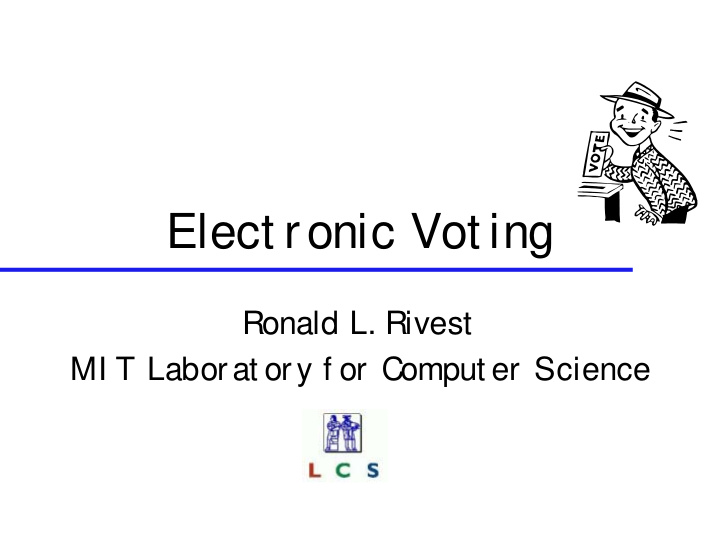



Elect ronic Vot ing Ronald L. Rivest MI T Laborat ory f or Comput er Science
Edison’s 1869 Vot ing Machine I nt ended f or use in Congress; never adopt ed because it was “t oo f ast ” !
The f amous “but t erf ly ballot ”
A “dimpled chad” ???
Vot ing Technology St udy ! MI T and CalTech have begun a j oint st udy of alt ernat ive vot ing t echnologies. ! Companion t o Cart er/ Ford commission on polit ical issues in vot ing syst ems. ! I nit ial work f unded by t he Carnegie Foundat ion.
Vot ing Technologies ! Poll-sit e vot ing: – Paper ballot (hand count ed) – Punched card (Vot omat ic; Dat avot e) – Lever Machine – Opt ical Scan – Elect ronic (DRE) – Mixed ! Remot e vot ing: – Absent ee – Kiosk – I nt ernet vot ing
Many kinds of equipment used Categories Punch Card DataVote Lever Machine Paper Ballots Optical Scan Electronic Mixed
Changes f rom 1980 t o 2000 Percentage of Counties Using Different Voting Technologies 45 40 35 30 Percentage of Counties 25 Series1 Series2 20 15 10 5 0 Paper Ballots Lever Machines VotoMatic DataVote Optically Electronic (DRE) Mixed Scanned Voting System (Chart f rom Prof . St eve Ansolabehere, MI T PoliSci)
Error Rat es by Technology Lever Machine Paper Ballot Mixed Optically Scanned VotoMatic Electronic (DRE) DataVote 0.00% 0.50% 1.00% 1.50% 2.00% 2.50% 3.00% 3.50%
Elect ronic Vot ing ! Could t he U.S. president ial elect ions be held on t he I nt ernet ? ! Why bot her? – I ncreased vot er convenience? – I ncreased vot er t urnout ? ? – I ncreased conf idence in result ? – “Because we can”?
Securit y Requirement s ! All eligible vot ers should be able t o vot e. – Theref ore: can at best augment current syst em, not replace it . – May need t o close elect ronic vot ing early. ! Vot es should be privat e (anonymous). – May be dif f icult t o ensure at home. ! Vot ers should not be able t o sell t heir vot es! – Vot ing should be privat e and “receipt -f ree” ! I nt egrit y and verif iabilit y of result ; no vulnerabilit y t o large-scale f raud.
The “FOO” Vot ing Scheme ! F uj ioka, O kamot o, and O ht a AUSCRYPT ’92, “A Pract ical Secret Vot ing Scheme f or Large Scale Elect ions” ! The basis f or t he MI T/ NTT collaborat ive research in elect ronic vot ing.
St ruct ure of Vot ing Scheme Administ rat or 1 2 Vot er 3 Anonymizer 5 Count er 4 6
The “Secure Plat f orm Problem” I n t heory: Vot ing SK A Syst em Alice I n f act : Vot ing Syst em SK A Alice
The Secure Plat f orm Problem ! Because of weaknesses in modern OS’s (Windows, UNI X), including vulnerabilit ies t o viruses and t roj an horses, we are not ready f or I nt ernet vot ing, and won’t be f or quit e a while. As t hey say, “ Don’t try this at home !! ”
Perhaps a smart phone? ! Promising, but st art ing t o look t oo much like a deskt op PC in t erms of complexit y and consequent vulnerabilit y… ! Maybe wit h a special SI M card j ust f or vot ing… ? ! Problems would remain: vot e-selling (allow vot ing mult iple t imes, where last one count s!)
Some personal opinions ! More import ant t hat no one has t heir t humb on t he scale t han having scale easy t o use or very accurat e . ! Can I convince my mom t hat syst em is t rust wort hy? ! Physical ballot s (e.g. paper) can provide bet t er audit t rails t han elect ronic syst ems.
More personal opinions: ! Precinct -based decisions on vot ing t echnology has benef it s: lack of unif ormit y allows f or experiment at ion and makes large-scale f raud harder. ! Abilit y t o handle disabled vot ers will become increasingly import ant . ! Biggest securit y problem has got t o be t he problem of absent ee ballot s . (Not e t hat absent ee ballot s were 30% of vot e in Calif ornia, and about 20% overall.)
My f avorit e t echnology (t oday) ! Fill-in bubbles on paper ballot s. Opt ically scan ballot s at polling sit e, bef ore ballot is deposit ed. Harvard Yale
(THE END)
Recommend
More recommend